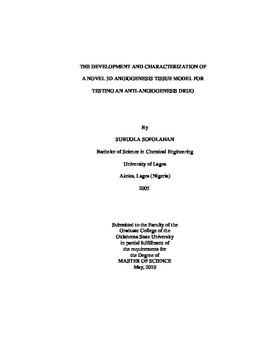| dc.contributor.author | Sofolahan, Subuola | |
| dc.date.accessioned | 2014-04-16T03:07:43Z | |
| dc.date.available | 2014-04-16T03:07:43Z | |
| dc.date.issued | 2010-05-01 | |
| dc.identifier.uri | https://hdl.handle.net/11244/9669 | |
| dc.description.abstract | Diabetic Retinopathy (DR) is a microvascular complication associated with diabetes mellitus and is the leading cause of blindness in American adults. DR occurs as a result of chronic hyperglycemia, which causes vascular damage, increased vascular permeability, vascular leakage, and edema. When the blood glucose level is elevated in the body, it can lead to a production of growth factors. Among the many growth factors present, vascular endothelial growth factor (VEGF) has been recognized as the primary mediator of vascular alteration in DR. Currently there is no non-invasive and effective drug treatment to prevent or arrest the progression of DR. Studies have shown that agents that block VEGF activity can prevent diabetes-induced retinal damage, thus the development of new drugs to block retinal vascular leakage via targeting VEGF or its receptor has become a potential new therapy for DR. Recently a novel anti-angiogenesis drug, a thalidomide analog, has been developed for the treatment of diabetic retinopathy. The objective of this research was to develop a three dimensional (3D) in vitro model to study the effect of an anti-angiogenesis drug on endothelial cell functions associated with angiogenesis. Initially, a model consisting of endothelial cells grown on bovine type 1 collagen gel formed within a 96 solid well plate was tested. Due to drawbacks associated with the model, a novel 3D model was created using Transwell permeable supports. The new model was characterized by varying collagen thickness at 0.73 mm, 2.01 mm and 4.28 mm and VEGF concentration at 5 ng/ml, 50 ng/ml, and 100 ng/ml. The higher VEGF concentrations of 50 ng/ml and 100 ng/ml showed greater stimulation of cell viability, proliferation, number of sprouts and migration than the 5 ng/ml concentration. However there was no significant increase in the endothelial cell functions for the 100 ng/ml of VEGF compared to the 50 ng/ml of VEGF. The 2.01 mm collagen thickness showed the greatest increase in cell viability and proliferation compared to the 0.73 mm and 4.28 mm thicknesses. The 0.73 mm collagen thickness showed the greatest increase in sprouting and migration compared to the 2.01 mm and 4.28 mm thicknesses. It can be concluded that the 0.73 mm collagen thickness and the 50 ng/ml VEGF concentration result in the optimal conditions suitable for testing the anti-angiogenesis drug in the new model. The 0.73 mm thickness was chosen as the most suitable collagen thickness, because it showed a significant effect on all four angiogenic steps: viability, proliferation sprouting, and migration. | |
| dc.format | application/pdf | |
| dc.language | en_US | |
| dc.publisher | Oklahoma State University | |
| dc.rights | Copyright is held by the author who has granted the Oklahoma State University Library the non-exclusive right to share this material in its institutional repository. Contact Digital Library Services at lib-dls@okstate.edu or 405-744-9161 for the permission policy on the use, reproduction or distribution of this material. | |
| dc.title | Development and Characterization of a Novel 3D Angiogenesis Tissue Model for Testing an Anti-Angiogenesis Drug | |
| dc.type | text | |
| osu.filename | Sofolahan_okstate_0664M_10887.pdf | |
| osu.college | Engineering, Architecture, and Technology | |
| osu.accesstype | Open Access | |
| dc.description.department | School of Chemical Engineering | |
| dc.type.genre | Thesis | |
| dc.subject.keywords | angiogenesis | |
| dc.subject.keywords | diabetic retinopathy | |
| dc.subject.keywords | in vitro | |
| dc.subject.keywords | novel 3d tissue model | |
| dc.subject.keywords | permeable membrane support | |
| dc.subject.keywords | vegf | |
